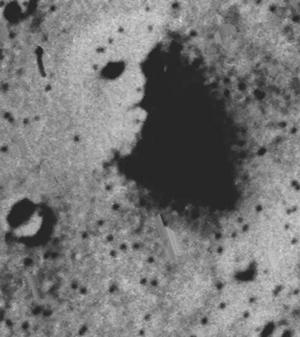|
INTRODUCTION: The "Face on Mars" is one of the great modern mysteries about Mars. The "Face" first came to our attention 35+ years ago, and debate about what it is has raged ever since. Let's hop in the Wayback Machine and return to 1976. The Viking spacecraft reached Mars in July of 1976. It had two missions. One was to send a lander down to inspect the surface of Mars. The other was to orbit the red planet, within a 1,000 miles of the surface, and take thousands of pictures to help to determine the best landing site for the Viking 2 spacecraft due to reach Mars in a few weeks. |
On July 26, 1976, during Viking 1's thirty-fifth orbit of Mars, a set of photographic images arrived at the Jet Propulsion Laboratory in Pasadena, California. One of the photographic frames, taken in the northern desert Cydonia region, showed a mile long, 1,500 mesa that looked like a humanoid face.
NASA has attempted to downplay this image from the start. After showing the JPL press corp a slide of this remarkable image, Viking project scientist Gerald Soffen attempted to explain it away by saying that a picture transmitted a few hours later, of the same region, revealed that the image in the first photo "...was just a trick, just the way the light fell on it."
SEEING IS/ISN'T BELIEVING:
When it comes to the Face on Mars, people tend to believe one of two things. That the "Face" is:
A. A striking pattern of light and shadow cast by hills in the area.
B. A sculpture carved by intelligent Martians.
According to author Robert C. Kiviat, "NASA's planetary scientists have maintained over the years that the face is a natural rock formation produced by wind erosion and that the particular lighting angle at which it was photographed created its resemblance to a human face."
A key member in the opposing camp is lead by Richard Hoagland, a former member of the JPL press corps, and the author of "The Monuments of Mars." Hoagland has led a long investigation into the Viking data. He and his team have analyzed different photographic frames, taken at different angles, weeks apart. He claims that he and his researchers have considerable evidence that the "face", as well as some nearby pyramid-shaped objects and other "artifacts," are the work of sentient creatures.
Hoagland first became involved with the Martian face in 1981. He attended a science conference where Vincent DiPietro and Gregory Molennar made a presentation. As Hoagland puts it, "These two computer-imaging experts had obtained data tapes of the face and had enhanced it. Their photographs showed some remarkable, stunning detail that was not at all evident on the raw image."
Hoagland came to agree with Molennar and DiPietro's contention that the face appeared bilaterally symmetrical. According to Hoagland, he saw that the face "...had features which were humanoid, and it seemed above chance that it also had the right proportion." It was at this point that Hoagland began to consider that the face might have been constructed by intelligent beings. By 1983, Hoagland came to be convinced of the face's intelligent origin, leading to his fifteen year quest to "prove" the face on Mars is proof of intelligent life on Mars, as well as to try to get NASA to a send a photographic mission to Mars with the primary purpose to get new, better shots of the Martian face.
Some people in the science community disagree with the conclusions of Hoagland and his people. According to Michael Carr, the head of the original Viking orbiter imaging team, "Not one person of scientific credibility believes this." As to the existence of Martian pyramids, in close proximity to the face, Carr states that he is not aware of a "single Viking image that has pyramids on it."
While Carr DOES agree that some JPL staff members DID notice the Cydonia mesa's resemblance to a face when that photographic image was originally received, he claims that it was published by the lab "only for laughs."
THE TWO FACES OF NASA:
NASA has claimed for years that the "face" on Mars is not a face and doesn't offer proof of intelligent life on Mars. Recently however, following new Mars pictures taken of the Cydonia mesa, NASA claimed that these pictures, which apparently show no face, are "proof" finally that the Martian face never existed. If NASA never believed the mesa was a face, why would they make such a big deal of "proving" the non-existence of something they never believed in the first place. That's like a guy buying land that supposedly has no oil beneath it, then digging a dry hole to "prove" there's no oil. Why bother?
CONCLUSION:
We find it ironic that NASA, who tried really hard to get the world to believe ancient bacteria on a meteorite came from Mars (which is looking more unlikely by the minute), would put so much energy into the notion that intelligent life couldn't/didn't exist on Mars. We thought NASA's mission was to explore space, reporting back to U.S. citizens, WHO PAY FOR ALL THIS THROUGH THEIR TAXES, whatever they find. Wouldn't finding proof of some ancient, Martian civilization be the greatest NASA accomplishment since sending men to the moon. You would think so.
Based on the "proof" currently available, we believe it is difficult to prove or disprove that the face on Mars is a genuine alien artifact. Until NASA sends a rover or manned team to the Cydonia region where the" face" is, the existence of an alien created face on Mars will remain a mystery.
We believe the American people are interested enough in the answer to this cosmic question to pay the bill. If intelligent, alien life once existed on Mars, the American people, as well as the world at large, deserves to know.
If NASA is ever to live up to the "Star Trek" credo, continuing to travel, "...where no man has gone before," a manned mission to the Cydonia desert region is a good place to start. NASA, make it so!
SOURCES for this Web-Page include: "Sky & Telescope, June 1991; "Omni, August 1994
Mars CoverUp Content Copyright © 1996 to by The Web Network Inc
BallCaps.com * HistoricClub.com * Nightmares.com * ReceptionMansion.com









